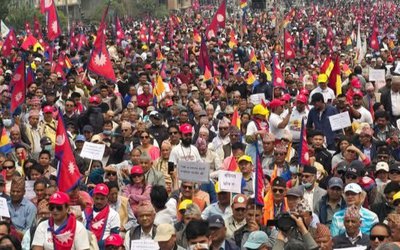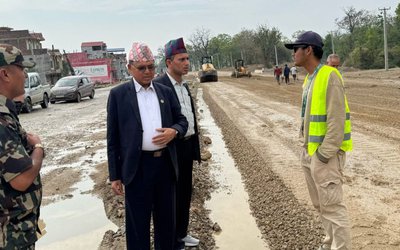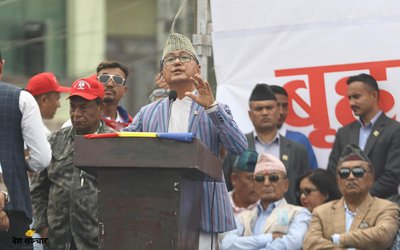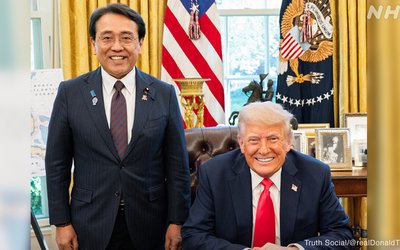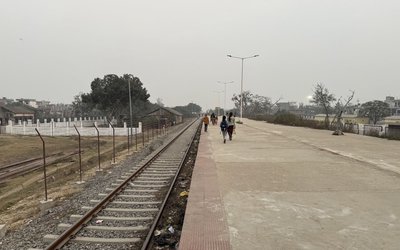
In the recently concluded elections in Nepal, the Left Alliance of the Nepal Communist Party – the Unified Marxist-Leninist (UML) and the Maoist Centre (MC) – has registered an impressive victory. They may not gain a two-thirds lead as claimed by them during the campaign but have a firm, comfortable majority in the national parliament. They are also a dominant force in six of the seven provincial assemblies.
The elections were held under Nepal’s new constitution adopted in September 2015. These elections will elect 275 members to the House of Representatives (HoR) and 550 representatives to the assemblies of the seven newly-created provinces.
In the parliament, while 165 seats have been filled by direct elections, on the basis of first-past-the-post (FPTP) basis, another 110 will be filled by proportional representation (PR), for which separate ballots were used. At the provincial level, 330 posts have been filled through the FPTP system, and another 220 will be nominated on the PR basis. Both these bodies will have 33% representation of women as mandated by the constitution. Any shortfall in women’s representation, as it is huge under FPTP declared results, will have to be made up by the political parties through the PR system.
What led to Left Alliance’s victory?
What explains this impressive performance of the
Left Alliance, forged just on the eve of elections? In the first place, credit
must go to the alliance leaders, K.P. Sharma Oli of the UML and Pushpa Kamal
Dahal of the Maoist Centre. Both of them carry a bit of a charisma – they are
articulate and effective communicators, have the organisational acumen and are
politically agile and manipulative. They were backed by their respective strong
organisational support and campaigned for giving Nepali people stability, peace
and prosperity.
There were doubts if the cadres of these two communist parties, which have been locked in an adversarial engagement of conflict and rivalry for years, would support each others’ candidates. The elections results have set such doubts aside.
The victory of the Left Alliance has been greatly facilitated by a weak and directionless opposition put up by the Nepali Congress (NC) led by Sher Bahadur Deuba. There was an attempt by the NC to forge a democratic alliance with the Madhes based and other non-Communist parties in order to counter the Left Alliance, but it failed to firm up. Considerations of personal egos, political turf and the lack of organisational resilience came in the way, so much so that in some places, Madhes-based leaders not only ended up contesting against the NC leaders but even fought and won on UML tickets. Some of the ranking Congress leaders like Bimalendra Nidhi were trounced by their rivals like Rajendra Mahto of the Madhes-based Rastriya Janata Party (RJP).
The Nepali Congress also ran a lacklustre campaign. Their main plank was to scare people against the possibility of the Left Alliance imposing a totalitarian state, which did not cut much ice with the Nepali voters. In their assessment, Nepal’s communist parties, barring their alienated extremists factions, have been democratised as they have come to power through ballot in the past and learned to share power and governance with the other democratic parties including the NC and the Madhes parties.
Nepali Congress said very little on its development agenda for Nepal and even failed to highlight many of its own achievements, such as always being in the forefront of Nepal’s struggle for democracy, ushering in the new constitution and holding all the three constitutionally mandated elections at the local, provincial and parliamentary levels in a short time of 18 months against heavy odds. No wonder then it has ended up with only 23 elected seats at the national level, though they are very close to the UML in PR votes.
Madhes parties also did not put up a strong electoral show. Except in Province 2, they lost in all other six provinces to the Left Alliance, both at the provincial as well as national level. With the exception of a couple of leaders, most were uninspiring in their campaign. They could not forge a firm unity amongst themselves and had two competing formations of the RJP and the Federal Socialist Forum of Nepal led by Upendra Yadav. Yet another important Madhes group of Tharu community led by Bijay Gachhadar even merged with the NC on the eve of the elections. This helped neither the NC nor the Tharus. Another emerging Madheshi leader C.K. Raut boycotted the elections and campaigned for voters to cast negative votes. He has been asking for an independent Madhes. As a result of fragmentation among the Madhes groups, the cause of Madhes accommodation pleaded by them has suffered on its political credibility at the national level.
An important aspect of the Nepal election has also been the rout of regressive forces that want Nepal to become a Hindu state under a constitutional monarchy.
This is evident in the miserable failure of the two Rastriya Prajatantra Party factions. All their leaders have lost and their vote count has suffered so severely that they will not be able to secure 3% of the total PR votes required to be recognised as ‘national parties’. Against them, two smaller parties which have also failed in securing the ‘national party’ status, have done better. They are Bibeksheel Sajha Party led by Rabindra Mishra and the Naya Shakti Party led by former Maoist Prime Minister Baburam Bhattarai. While the Sajha Party has failed to get elected at the national or provincial level, it has secured nearly two lakh PR votes and stands sixth after the RJP in that order. The Naya Shakti Party has failed to garner much PR votes but has succeeded in sending one representative to parliament and two to provincial assemblies. Both these new parties stand for a corruption free and transparent political system and good, people-centric governance.
It would be a mistake to read the emergence of Left Alliance as Nepal’s preference for communism. In their vote for the alliance, Nepali voters have clearly expressed their new nationalism which has three key components – search for political stability and peace, demand for fast and comprehensive development and assertion against India. While under a monarchy, Nepal was governed as a rentier state without any concern for the well-being of the people, since the beginning of the 1990s, Nepalis have lived with violence and instability precipitated by the Maoist insurgency.
The successful people’s movement of 2005-06 and the mainstreaming of the Maoists unleashed hopes and aspirations of ordinary Nepalese for stability and development. These aspirations were however belied by the Nepali politicians’ continued power struggle and lack of institutionalisation of democracy due to perennial political instability. Even the reconstruction of earthquake-inflicted destruction was ignored in the midst of political games. Now after the adoption of the new constitution, Nepalis want order, stability and development.
The main question before the new Left Alliance government would be to address these Nepali aspirations by measuring up to the promises made in this respect during the election campaign by the top UML and Maoist leaders. The very first pre-condition for the Left Alliance to perform on their promises is to maintain their unity, even if they fail to forge the promised merger of the two parties. And this may not prove to be easy for the UML and the Maoists as they have serious ideological differences, and divergent political approaches regarding some of the key political and constitutional issues like constitutional amendments for accommodating the remaining Madhes demands, working of the Truth and Reconciliation Commission to complete the peace process, creation of new institutions like the ‘Executive/Effective Presidency’ and working out credible power-sharing arrangements to satisfy their respective cadres.
The Left Alliance is not likely to get a two-thirds majority after the PR votes are added and this will force them to take the opposition groups on board for any constitutional change. Both Oli and Prachanda have led governments at different times and under different political arrangements. They are known for efficient power management and political consolidation. They have to desist from the politics of patronage and party/personal control of constitutional and governing institutions they have been apt in pursuing so far.
This is a tall order and time will tell how the Left Alliance unfolds itself in carrying it out satisfactorily. Strains in any of these areas can impinge heavily on the unity of the alliance. In the final analysis after the PR vote counting, the UML may not have an absolute majority on their own (The UML has 80 seats and they may need 50 plus more for absolute majority from the PR quota which does nook look possible), prompting the Maoists to look for greener pastures elsewhere if the alliance keeps them uncomfortable as a subordinate partner. The possibility of Oli reaching out to either NC or Madhes-based parties to liberate himself from the Maoists is a rather remote proposition.
Outside the domestic challenge, the Left Alliance also has to cope with its two giant neighbours – India and China. UML under Oli had opened Nepal’s option of cultivating China to diversify its heavy dependence on India in the matters of trade and transit. Prachanda’s and his Maoists constituencies around, have always looked towards China as a counterbalance to pressures from India. Since the launching of its Belt and Road Initiative, China is also keen to expand its economic engagement and strategic space in Nepal under the excuse of facilitating Oli’s and Prachanda’s developmental agenda. China was looking forward to the victory of the Left Alliance, it is assiduously working to see this alliance turn into a single party to help it enthusiastically carry forward its economic and strategic initiatives in Nepal.
The Left Alliance had objected to the Deuba government’s cancellation of the Budhi Gandaki power project with a Chinese concern and promised to reverse this decision. In pursuing its engagement with China, the Left Alliance may find it prudent to be careful on two counts. One, it should avoid in concluding with China such projects that lure it to walk into a long-term debt-trap, as has been the case with countries like Sri Lanka, Myanmar, Maldives, or even Pakistan. Secondly, it may be well advised to steer clear of such projects that may trigger India’s security sensitivities and concerns. Both Oli and Prachanda are intelligent and experienced leaders. They are acutely aware of the structural constraints and avoidable redlines inherent in India-Nepal relations. That is why they have repeatedly and publicly been stating to bring a balance in building co-operative relations with both their northern and southern neighbours. Lets us hope that they create a new and credible framework of Nepal’s foreign policy to do so.
The Left Alliance has come as a bad news to New Delhi. Unfortunately, India has unwittingly contributed to the rise of both the Left Alliance and the new Nepali nationalism with anti-India undertones. Recall some of the past development’s in India-Nepal relations – Delhi’s brazen diplomatic intervention in Nepal’s constitutional process through the sending of its foreign secretary to halt that process in September 2015; Its coercive economic diplomacy to punish Oli for not responding to its constitutional preferences regarding accommodation of the Madhesi demands; Its blessings for unseating Oli once by supporting Sushil Koirala against him in 2015 and then by encouraging Prachanda to defect and align with the NC in 2016.
All this not only alienated Oli who remained a friend of India for several decades, but also infuriated Nepali people by hurting them in the wake of coercive economic diplomacy. This created conditions for Oli to cleverly exploit Nepali sentiments against India and the Madhes to crystalise an anti-India nationalism and consolidate his power base on it. By opening up the Chinese option in the ‘wake of coercion from India’ he successfully projected his image of being a strong leader who could brave Indian pressures. The election results are a reward for his deft political moves in this respect.
India has now to cope with the victory of the Left
Alliance and the new Nepali nationalism. There are strategic planners in the
Prime Minister’s Office, the external affairs ministry and other ruling stables
to whom the option of breaking the Left Alliance would come easily. Any such
shortsighted move will be a disaster for India’s Nepal policy. If the alliance
has to break, it will do so on its own as many of its internal tensions have
been identified earlier. There are also political heavyweights within the
ruling BJP that would want to turn Nepal into a Hindu state and revive its
constitutional monarchy for resisting the rise of the communists and China in
Nepal. They need to learn from the electoral outcome that Nepalese have smashed
the forces of feudalism and Hindutva.
India, instead of launching on these disastrous adventures, must help the alliance stabilise and give good governance to the Nepali people. India has to take initiatives to firmly demonstrate, not through words but actions, that it is a true friend of the Nepali people and sincerely wants to cooperate in their developmental efforts. It must complete long pending projects in Nepal and initiate such new ones that create confidence and goodwill among ordinary Nepalese.
This is not the first time that India has had to deal with a communist regime in Kathmandu. As Nepalis, particularly the communist parties, are keen on revising some of the old agreements and treaties, like the one of 1950 on Peace and Friendship, India must respond to it sincerely and ensure that while protecting its core interests, Nepal’s sentiments are also respected. India has done this in case of Bhutan and should do the same for Nepal. Though the Chinese challenge is becoming formidable for India in its immediate neighbourhood, Indian policymakers must accept that the neighbouring countries’ affection for China is considerably shaped by their alienation from India. Part of the challenge of China in the neighbourhood can be met by India by revisiting and recasting some of its own critical policy options towards smaller neighbours.
Courtesy: The Wire




